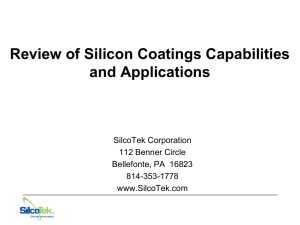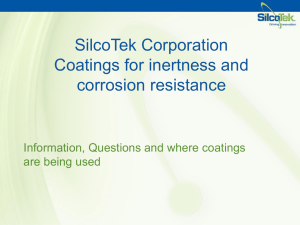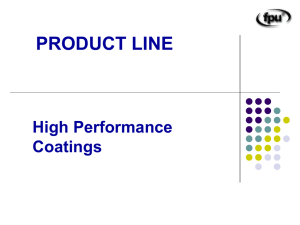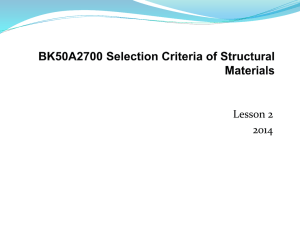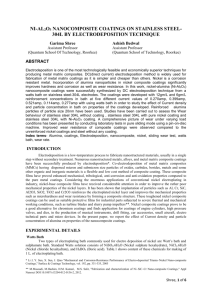Improving the Release of Moisture from Stainless Steel to
advertisement
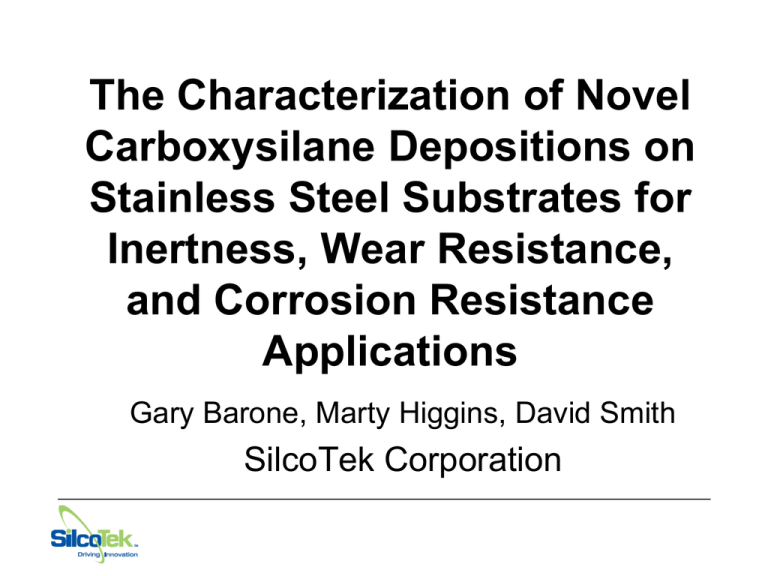
The Characterization of Novel Carboxysilane Depositions on Stainless Steel Substrates for Inertness, Wear Resistance, and Corrosion Resistance Applications Gary Barone, Marty Higgins, David Smith SilcoTek Corporation Overview • Use of Coatings • Selecting Coatings – Coating Materials/Properties – Durability – Corrosion Testing – Moisture Resistance – Chemical Inertness • Conclusion Using Coatings • Most analytical pathways are stainless steel – Great structurally – Good corrosion resistance – Poor chemical properties for analytical chemists • Coatings used to improve material properties. • Industries are demanding harsher services for silicon coatings (like SilcoNert® 2000 (Sulfinert). • Carboxysilane coatings (Dursan®) more robust. Factors Contributing to Poor Sampling Reliability • • • • Durability/Wear Corrosion Moisture Design – Chemical & Material Compatibility/Inertness – Instrument Compatibility – Installation Selecting Coatings • Fluoropolymers – Very inert – Very corrosion resistant – Broad pH applicability – Poor adhesion – Poor wear resistance – Good to 260°C • Silicon (SilcoNert® 2000) – – – – – – – – Very inert Great adhesion No carryover Good corrosion resistance Limited pH range Susceptible to steam cleaning Poor wear resistance Good to 450°C New Coating • Carboxysilane (Dursan®) – – – – – – – – – Good inertness Great adhesion No carryover Good corrosion resistance Broad pH applicability Steam cleaning, no problem Good wear resistance Tested to 450°C Still accumulating application data Coating/Material Properties Property Silicon (SilcoNert 2000) Carboxysilane Dursan PTFE, PFA Max Temperature 450ºC 450ºC 260ºC Min Temperature -196ºC -100ºC -240ºC Low pH limit 0 0 0 High pH limit 7 14 14 Thickness 0.12um to 0.5um 0.5um to 1.0um 25um Adhesion Very Good Very Good Poor Wear resistance 90% of Stainless 2 times 316 Stainless 10% of SS (est.) Moisture contact 72-90° 104-140° 125° Inertness vs. SS Excellent Good Excellent Improving wear resistance & Durability • Equipment and sample conditions can damage surfaces and increase activity. • Valve cycling/purging cause delamination • Particulate in sample streams • Abrasive cleaning • Existing coatings • Prone to wear • Easily damaged • Result: Adsorption & loss of sample Wear and Friction Data • Pin on Disc: ASTM G133 • Base substrate is mirror-finish SS 316 Avg. Coeff. Friction Wear Rate (x10-5mm3/Nm) Uncoated SS 0.589 13.810 Carboxysilane (Dursan) 0.378 6.129 0.7 14.00 Silicon (SilcoNert 2000) Load 2.0 N Duration 20 min Speed 80 rpm Radius 3mm Revolutions 1,554 Ball Diameter 6mm Ball Material SS 440 Courtesy of Nanovea Inc. Pull Strength Measurements • Paints delaminated from the stainless steel Pull Strength Measurements • Dursan more “slippery” difficult to bond adhesive. Adhesive bond failed before coating. Demonstrating reduced friction characteristics. Challenge of Corrosion • Samples can contain corrosives that quickly attack stainless – Hydrochloric acid (HCl) – Sulfuric acid (H2SO4) – Saltwater • Physical loss of equipment due to corrosion – Maintenance – Replacement cycles • Corrosion increases surface activity and particulates • Silicon coatings susceptible to caustics Acid Corrosion Resistance • ASTM G31 Guidelines: 6M HCl; 24hr; 23ºC MPY Improvement Factor over 316L stainless 316L SS Silicon Carboxysilane 181.98 4.32 0.44 --- 42 411 Dursan coated Photo after 19hr exposure Silcolloy coated Acid Corrosion Resistance ASTM G31 5% HF 70% Nitric 85% Phosphoric 25% Sulfuric MPY rate factor MPY rate factor MPY rate factor MPY rate factor 120.00 - 0.78 - 0.62 - 54.64 - Carboxysilane 80.38 1.49 0.10 7.50 0.08 8.00 5.36 10.19 Silicon 44.26 2.71 0.36 2.14 0.28 2.18 23.62 2.31 316 SS Exposure to Caustic Base • 1M KOH; 24hr; 22ºC ASTM G31 316L SS Silicon Carboxysilane MPY 0 3.40 0.01 Improvement Factor Infinite Dissolution 261 Over Silicon Challenges of Moisture • Benefits of coating that help release water faster – Components less susceptible to corrosion – Faster cycle times – Increased accuracy – Eliminate moisture/sample interaction Impact of Moisture 110 100 Presence of moisture in sampling system reduced H2S response by 22%: 50ppm sample 90 Day 1 Day 14 80 70 60 Dry H2S Sample (%) H2S with Moisture (%) Measuring Hydrophobicity Kruss K100 Tensiometer Testing on 304 SS ¼” OD tubing DI Water 304 SS SilcoNert Dursan PTFE 2000 Advancing 36.0 87.3 105.5 125.4 Receding 5.3 51.5 85.3 84 DI Water Contact Angle Illustrations (advancing) on flat surfaces: 304 SS SilcoNert 2000 Dursan Chemical Inertness • Stainless Steel: – Adsorbs sulfur compounds – Causes loss of mercury – Demonstrates poor transportability (tailing) of polar organics such as alcohols – Adsorbs ammonia • Need coating that is chemically inert for analytical systems Total Sulfur Recovery 36ppb & 25ppm, 300cc cylinder % Recovery SilcoNert: 36ppb 99%+ recovery 100 95 90 85 80 75 70 65 60 55 50 Dursan: 25ppm 97% Recovery SS 80% loss in 1 day 0 2 4 6 Day 8 10 12 Mercury 50 Day Stability Average Mercury Concentration (ug/m 3) Average Mercury Response Comparison of Stainless Steel vs. Silicon Functionalized Surfaces 7 6 5 4 3 2 1 0 0 10 20 30 40 50 Days after fill Untreated cylinders (n=2) Functionalized cylinders (n=2) Courtesy of Spectra Gases Inc. 21 60 Ammonia Adsorption 100PPV, 500sccm, 1.8m tubing, min • • • • Measured PTR-MS signals of ammonia (m17). At t=10min the gas stream was switched in a way that it passed additionally the different 1.8m long lines. The PFA line seems to be best for Ammonia, while the steel line completely adsorbs the 100ppbv of Ammonia in the sample gas for hours. All lines were 1.8 m, not heated (30°C), sample gas flow was 500 sccm (std. ml/min) of 100 ppb of ammonia in N2. Courtesy of IONIMED Analytik Silicon (SilcoNert ) Durability Poor wear resistance Fair wear resistance Good wear resistance Corrosion Excellent Good Good Moisture Excellent Good Excellent Inertness Excellent Excellent/ no carryover Good Chemical / Material Compatibility Poor adhesion/ Broad pH range Excellent adhesion Excellent Instrument Compatibility Good Good Excellent Installation 260c max 450c max 450c max Weight Fluoropolymers Weight Factor Carboxysilane (Dursan) Weight Selecting Coatings Conclusion • Analytical and Process industries demanding increased performance from coating • Coating selection dictated by application – – – – Corrosion resistance Moisture resistance Inertness Wear • Broad spectrum environments and applications may involve a tradeoff in performance. – In field applications, carboxysilane coatings (Dursan) may be the best overall performer.
